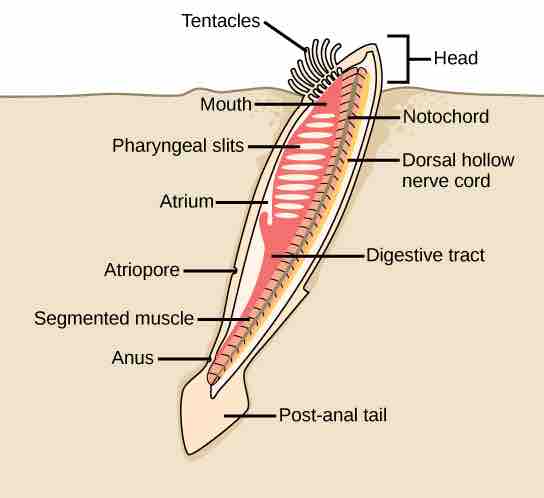Chordates and the Evolution of Vertebrates
The most familiar group of chordates is the vertebrates. However, in addition to the subphylum Vertebrata, the phylum Chordata also contains two subphylums of invertebrates: Urochordata and Cephalochordata. Members of these groups also possess the four distinctive features of chordates at some point during their development: a notochord, a dorsal hollow nerve cord, pharyngeal slits, and a post-anal tail. Unlike vertebrates, urochordates and cephalochordates never develop a bony backbone.
Urochordata
Members of Urochordata are also known as tunicates . The name tunicate derives from the cellulose-like carbohydrate material, called the tunic, which covers the outer body of tunicates. Although tunicates are classified as chordates, only the larval form possesses all four common structures. Adults only maintain pharyngeal slits and lack a notochord, a dorsal hollow nerve cord, and a post-anal tail.

Urochordates
(a) This photograph shows a colony of the tunicate Botrylloides violaceus. (b) The larval stage of the tunicate possesses all of the features characteristic of chordates: a notochord, a dorsal hollow nerve cord, pharyngeal slits, and a post-anal tail. (c) In the adult stage, the notochord, nerve cord, and tail disappear.
Most tunicates are hermaphrodites. Tunicate larvae hatch from eggs inside the adult tunicate's body. After hatching, a tunicate larva swims for a few days until it finds a suitable surface on which it can attach, usually in a dark or shaded location. It then attaches via the head to the surface and undergoes metamorphosis into the adult form, at which point the notochord, nerve cord, and tail disappear.
Most tunicates live a sessile existence on the ocean floor and are suspension feeders. The primary foods of tunicates are plankton and detritus. Seawater enters the tunicate's body through its incurrent siphon. Suspended material is filtered out of this water by a mucous net (pharyngeal slits) and is passed into the intestine via the action of cilia. The anus empties into the excurrent siphon, which expels wastes and water. Tunicates are found in shallow ocean waters around the world.
Cephalochordata
Members of Cephalochordata possess a notochord, dorsal hollow nerve cord, pharyngeal slits, and a post-anal tail in the adult stage. They do not have a true brain, but the notochord extends into the head, which gives the subphylum its name ( "cephalo" is Greek for head). Extinct members of this subphylum include Pikaia, which is the oldest known cephalochordate. Pikaia fossils were recovered from the Burgess shales of Canada and dated to the middle of the Cambrian age, making them more than 500 million years old.
Extant members of Cephalochordata are the lancelets, named for their blade-like shape. Lancelets are only a few centimeters long and are usually found buried in sand at the bottom of warm temperate and tropical seas. Like tunicates, they are suspension feeders . With notochord and paired muscle blocks, the lancelet and Pikaia may belong to the chordate group of animals from which the vertebrates have descended.

Cephalochrodates
The lancelet, like all cephalochordates, has a head. Adult lancelets retain the four key features of chordates: a notochord, a dorsal hollow nerve cord, pharyngeal slits, and a post-anal tail. Water from the mouth enters the pharyngeal slits, which filter out food particles. The filtered water then collects in the atrium and exits through the atriopore.